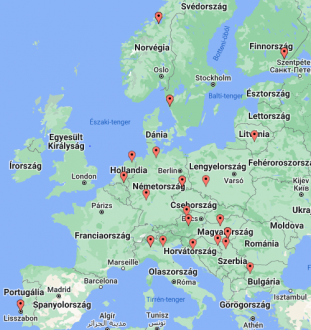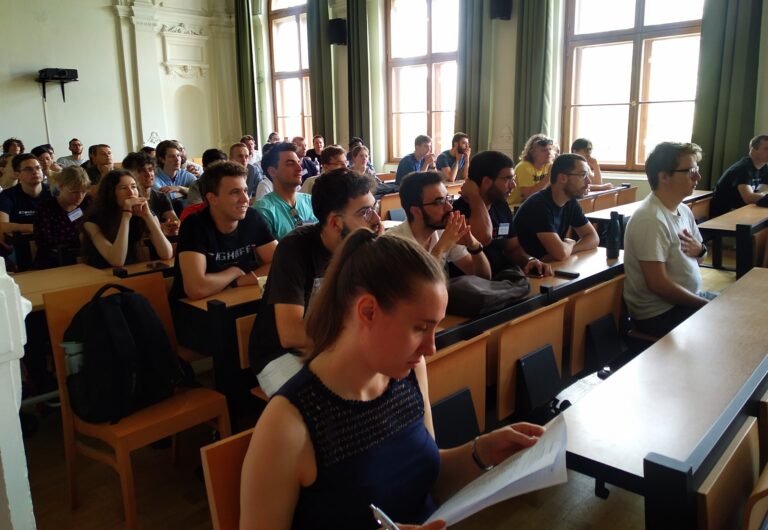The Bolyai Institute of the University of Szeged is the first in Hungary to organise the 36th Modelling Week for students of the European Consortium for Mathematics in Industry (ECMI). The workshop will bring together 52 European students from 14 countries to find mathematical solutions to ten practical problems in the fields of frontier sciences and industry.
Between 9-16 July, the European Consortium for Mathematics in Industry (ECMI) organised a student workshop at the Bolyai Institute of the University of Szeged, with the participation of 52 international students.The pan-European organisation aims to promote the application of mathematics in industry, economy, social and environmental problems, and to disseminate quality-assured best practices developed by its members across Europe. The ECMI is composed of university departments, institutes, applied mathematics research centres and companies using mathematical modelling. The Bolyai Institute of the University of Szeged has been a member since 2018 and mathematician Dr. Gergely Röst is a member of the ECMI's Education Committee. In addition to organising events bringing together industry and academia, ECMI also has training activities for higher education. The organisation has developed a European model curriculum for master programs in applied mathematics, and higher education institutions can accredit their own training courses to become ECMI teaching centres, and their students have the opportunity to obtain the ECMI certificate alongside their diplomas.

Dr. Gergely Röst, Head of the Department of Applied and Numerical Mathematics at the University of Szeged, and the scientific director of the National Laboratory for Health Security, said that the industrial mathematics specialization of the Master's Degree in Applied Mathematics of the University of Szeged was created to harmonize with the ECMI standard European curriculum. The Bolyai Institute then accredited the program, and the University of Szeged became an ECMI training centre. Last year, students from the University of Szeged participated for the first time in the ECMI modelling week in Verona. And this year, Boróka Jankus, the first student from Szeged to receive an ECMI certificate in addition to her mathematics degree, graduated.
- The advantage for our students is that they have the opportunity to obtain an ECMI certificate at the University of Szeged. In addition to completing the courses and passing the exams, the diploma requires that the thesis is written in English on a topic in industrial mathematics, and that the student attends an ECMI modelling week.
Since 1987, the ECMI has organised an annual modelling week for students in different European cities.. This year's workshop will be the first in Hungary to be held in Szeged, at the Bolyai Institute of the University of Szeged. Dr Gergely Röst said that the event requires students to work in 10 teams to find an answer with the help of mathematical modelling to a real-world problem. Each of the problems was presented to the group by an instructor with expertise in the field, and the students would work out a mathematical solution based on the instructor's guidance throughout the week. During the last days of the modelling week, the ECMI Education Committee also met at the Bolyai Institute of the University of Szeged, and on the final day the committee listened to the students' presentations. The workshop is mainly aimed at Master's students, but some BSc students with exceptional skills were also present in the groups. For a successful presentation, students can receive course credits along with their certificate.

Five of the ten problems to be solved during this year's modelling week were posed by companies and research institutes associated with the Bolyai Institute. Dr. Gergely Röst was asked to introduce each of the modelling projects:
In the group led by Dr. Zsolt Vizi (SZTE) and Péter Kozák (ATIVIZIG, Water Directorate of Southern Hungary), the problem was about predicting the water level of the river Tisza, where floods are quite common. The students were asked to design a mathematical prediction tool that can predict the runoff of the Tisza water levels based on a large amount of data measured over 30 years on the Tisza and its tributaries. The result here will be a data-driven machine learning model with a special mathematical structure due to the fact that the data are not only from the Tisza, but also from its tributaries and tributaries of tributaries. As a prerequisite for the solution, the mathematical model must provide as accurate a prediction as possible, while at the same time being simple enough to meet the computational needs of an ordinary computing capacity.
The workshop will also give students the opportunity to reflect on two epidemic-related problems. For the National Laboratory for Health Security, the task was to run a scenario exercise for the avian influenza epidemic, which is currently under increased scrutiny by the epidemic modellers. The group's instructor, Dr. Beatrix Oroszi, a lead epidemiologist of Hungary, presented the students with an epidemic situation in which a mutation of avian influenza became capable of human transmission and triggered a new pandemic. For the modelling, it was known how many vaccines were available, for how long, and with how much efficacy. Students had to calculate how much of the vaccine to give to particular age groups to best contain the hypothetical pandemic.
The data for the other pandemic problem was brought to us by Seyed Moghadas from York University in Toronto, Canada. The task was to process a Covid database using data analysis methods. The Canadian case database contains anonymised information on infected persons, hospitalised or admitted to intensive care units by age group, and the students have to calculate the risk exposure of each social group at the time of each wave.
From ELI ALPS (Extreme Light Infrastructure), Dr. Attila Czirják and Dr. Attila Tóth brought a problem related to the phenomenon of attosecond pulse excitation to the modelling week. The task here was to develop a simulation code based on a numerical approach to the Schrödinger differential equation. The basic quantum mechanical equation was to describe the interaction of an ultrashort, high peak intensity laser pulse with a single atom in a numerically feasible way, but with the highest possible accuracy.

Also requiring an analytical solution was a light-related task from Ireneusz Augustyniak (Wroclaw University of Science and Technology) from Poland, to model the optical vortex beam of a scanning electron microscope.
Martijn Anthonissen (Eindhoven University of Technology) gave the students a topic on the design of environmental lighting. The problem posed the question of what optical system should be used to obtain the illumination pattern at a given point. This question of illumination is usually posed in reverse, calculating the light from a given light source, but in this case the problem was the inverse, calculating the required system of light sources and mirror to obtain a desired light distribution, which required numerical solution of differential equations.
The workshop also included practical exercises requiring complex mathematical models. Mantas Landauskas (Kaunas University of Technology, Lithuania) posed the problem of how to predict the life of ball bearings in railway cars for the Lithuanian railway company. In order to effectively manage bearings that wear out under changing conditions, it would be good to be able to predict bearing deterioration. NASA's public bearing database provided the data for the task, and the goal was to look for patterns in the bearing vibration data.

Even more practical modelling task is related to the problem of Szabolcs Szalánczi and Péter Zalka (B+N Referencia Zrt.). Here, the students have to solve a problem of a facility management company with mathematical algorithms, and more specifically, the question of how to control cleaning robots efficiently in unknown terrain. The cleaning robot has cameras, but the camera does not detect depth, but has to create a three-dimensional reconstruction of the geometry of the environment from camera images taken from several different points. To illustrate the task, the instructors have installed such cameras in the modelling classroom.
Dora Selesi from the University of Novi Sad brought an actuarial exercise to the modelling week. The students' task was to use a customer database to find a model that could predict how much accident damage a customer of a given age, with a given car, in a given municipality, is likely to cause in the coming years. This calculation will determine the premium that the insurer will charge the customer for a non-life insurance policy.
The task of the tenth group was instructed by Dr. Péter Boldog, from the Bolyai Institute and the Wigner Research Centre for Physics. In this case, the evolution of a population of cells had to be simulated efficiently, with each cell being a separate entity that moves and divides. The goal was to develop a stochastic simulation framework that could represent the evolution of cell cultures over time, primarily to study the effects of drug administration.
Dr. Gergely Röst also explained that students were assigned to each topic according to their preferences, with students having to pre-select at least three out of ten topics, but also making sure that the teams were as heterogeneous as possible.

A modellezési hetet kedden látogattuk meg, és megkérdeztük róla Urszuly Csengét, a jelenleg Hollandiában tanuló szegedi matematika szakos hallgatót. Csenge 2023-ban egyedülálló módon másodéves alapszakosként nyert első helyezést az OTDK-n Dr. Ferenci Tamás és Dr. Röst Gergely témavezetésével. A második évet végzett hallgató hollandiai tanulmánya során egy pályázat révén lehetőséget kapott, hogy 2022 nyarán valamelyik magyar egyetem kutatómunkájában részt vegyen. – Én Röst Gergelyt kerestem meg, akinek vezetésével a Covid-kutatás egy előrejelző szervezetének munkáját értékeltük ki. Tőle hallottam az ECMI európai modellezési hétről, amelyen a matematika csapatmunkában történő alkalmazásáról szeretnék tapasztalatot szerezni – mondta Urszuly Csenge.
At the workshop, Csenge chose the cell population project. When asked if it was possible to find a mathematical solution to a biological problem, one that she had not previously studied in depth, she replied:
- Of course, the basics need to be well understood. In the preparation we learned about the fundamental processes of the cells, we understood phases of division,and how a drug can act on them. We also went through the technicalities of programming, the tools we would need for simulation. We are now starting to sketch out the details of the problem and what mathematical methods we will use. We didn't need that much detailed biological knowledge, that's what was so special about it, that with good mathematical skills and interest you could understand the phenomenon enough to be able to tackle the problem. This week has shown that, as an applied mathematician, when faced with a new challenge, one can successfully approach any problem with reason and logic.

Dr Gergely Röst has a similar opinion on the broad applicability of mathematics:
- The mathematical knowledge and methods are quite transferable. For example, anyone who has learned differential equations thoroughly at university can be involved in simulating a laser-excited atom just as in modelling preparations for avian flu. Stochastics, the mathematics of randomness, which has also emerged in a variety of topics, also provides a broadly applicable toolbox. And whenever there are large datasets, whether of cells, bearing balls or water level measurements, data science methods or machine learning tools can be used in a general way. Mathematics is also an excellent tool for interdisciplinary research and industrial development, because it can relate so well to so many problems.
The students worked very hard throughout the week, but the organizers ensured that they can enjoy social events as well, to make their stay in Szeged even more memorable. Besides the opening reception and the final gala dinner, there were physical activities such as a football game, dragonboat peddling on the river, and a tour to the botanical garden. The students also visited one of the world’s largest exhibition of mechanical puzzles.
This is a translation of a Hungarian article written by Sándor Panek
On the cover image: the European Consortium for Mathematics in Industry (ECMI) Modelling Week at the Bolyai Institute.



